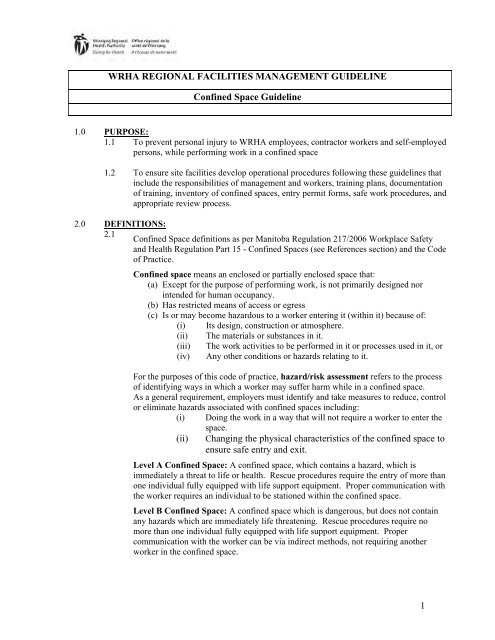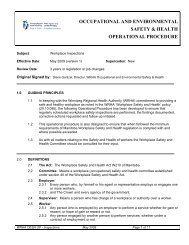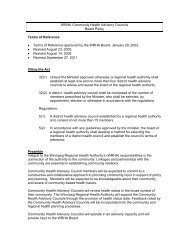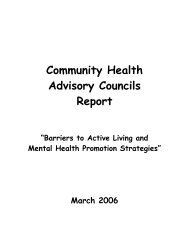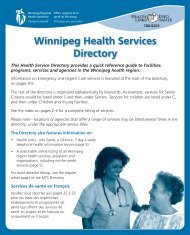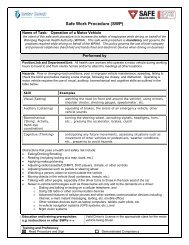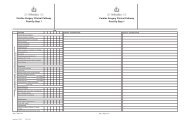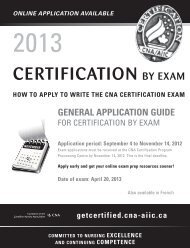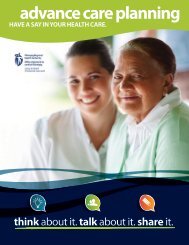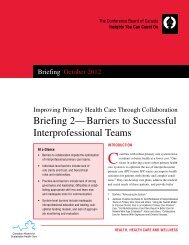WRHA Guideline Confined Space - Winnipeg Regional Health ...
WRHA Guideline Confined Space - Winnipeg Regional Health ...
WRHA Guideline Confined Space - Winnipeg Regional Health ...
Create successful ePaper yourself
Turn your PDF publications into a flip-book with our unique Google optimized e-Paper software.
<strong>WRHA</strong> REGIONAL FACILITIES MANAGEMENT GUIDELINE<br />
<strong>Confined</strong> <strong>Space</strong> <strong>Guideline</strong><br />
1.0 PURPOSE:<br />
1.1 To prevent personal injury to <strong>WRHA</strong> employees, contractor workers and self-employed<br />
persons, while performing work in a confined space<br />
1.2 To ensure site facilities develop operational procedures following these guidelines that<br />
include the responsibilities of management and workers, training plans, documentation<br />
of training, inventory of confined spaces, entry permit forms, safe work procedures, and<br />
appropriate review process.<br />
2.0 DEFINITIONS:<br />
2.1<br />
<strong>Confined</strong> <strong>Space</strong> definitions as per Manitoba Regulation 217/2006 Workplace Safety<br />
and <strong>Health</strong> Regulation Part 15 - <strong>Confined</strong> <strong>Space</strong>s (see References section) and the Code<br />
of Practice.<br />
<strong>Confined</strong> space means an enclosed or partially enclosed space that:<br />
(a) Except for the purpose of performing work, is not primarily designed nor<br />
intended for human occupancy.<br />
(b) Has restricted means of access or egress<br />
(c) Is or may become hazardous to a worker entering it (within it) because of:<br />
(i) Its design, construction or atmosphere.<br />
(ii) The materials or substances in it.<br />
(iii) The work activities to be performed in it or processes used in it, or<br />
(iv) Any other conditions or hazards relating to it.<br />
For the purposes of this code of practice, hazard/risk assessment refers to the process<br />
of identifying ways in which a worker may suffer harm while in a confined space.<br />
As a general requirement, employers must identify and take measures to reduce, control<br />
or eliminate hazards associated with confined spaces including:<br />
(i) Doing the work in a way that will not require a worker to enter the<br />
space.<br />
(ii) Changing the physical characteristics of the confined space to<br />
ensure safe entry and exit.<br />
Level A <strong>Confined</strong> <strong>Space</strong>: A confined space, which contains a hazard, which is<br />
immediately a threat to life or health. Rescue procedures require the entry of more than<br />
one individual fully equipped with life support equipment. Proper communication with<br />
the worker requires an individual to be stationed within the confined space.<br />
Level B <strong>Confined</strong> <strong>Space</strong>: A confined space which is dangerous, but does not contain<br />
any hazards which are immediately life threatening. Rescue procedures require no<br />
more than one individual fully equipped with life support equipment. Proper<br />
communication with the worker can be via indirect methods, not requiring another<br />
worker in the confined space.<br />
1
<strong>WRHA</strong> REGIONAL FACILITIES MANAGEMENT GUIDELINE<br />
<strong>Confined</strong> <strong>Space</strong> <strong>Guideline</strong><br />
Level C <strong>Confined</strong> <strong>Space</strong>: A confined space that does not contain any exposed hazard<br />
risk capable of causing death or serious harm, or would not require special modification<br />
procedures. Standard rescue procedures in the event of worker injury can be utilized.<br />
Proper communication with the worker can be via indirect methods, not requiring<br />
another worker in the confined space. Working Alone or In Isolation procedures may<br />
apply.<br />
2.2 Qualified Persons – a qualified person (in regards to confined spaces) is one who has<br />
been trained in the risk assessment, entry, rescue and testing required for entry into a<br />
confined space. This designation requires ongoing retraining to ensure that the<br />
individual is appropriately skilled and current in all elements of confined space entry.<br />
3.0 GUIDELINES:<br />
3.1 <strong>Confined</strong> <strong>Space</strong>s shall be identified and assessed by qualified persons and a Job Hazard<br />
Analysis (JHA) shall be performed for each <strong>Confined</strong> <strong>Space</strong>.<br />
3.1.1 Where the risk assessment JHA identifies work procedures, skills or equipment<br />
requirements that may create hazards, such as hot work, workers shall refer to<br />
and abide by the applicable policy for that type of work.<br />
3.2 Classify and label all confined spaces to the varying degrees of hazards.<br />
3.2.1 Utilize Table A. as the basis for a risk assessment and space hazard<br />
classification.<br />
3.2.2 Classification of a space may change depending on the work being performed<br />
(i.e. welding, painting with epoxy in a class C will require risk assessment and<br />
permit).<br />
3.2.3 Signs must be posted indicating the class of confined space at all entry points to<br />
a confined space. Danger signs are required for Class A confined spaces and<br />
must also indicate the Permit requirements. Caution signs are required for<br />
Class B & C confined spaces and must refer to reader to any site safety<br />
requirements.<br />
3.3 Site-specific Safe Work Procedures (SWP’s) for <strong>Confined</strong> <strong>Space</strong>s shall be developed in<br />
consultation with the site Workplace Safety and <strong>Health</strong> Committee.<br />
3.3.1 Class A spaces require site specific and job specific safety procedures.<br />
Appropriate monitoring, control of the hazards, communications, rescue<br />
procedures, standby personnel, rescue equipment and permits are required for<br />
all Class A spaces.<br />
3.3.2 Class B spaces require site-specific safety procedures according to the risk<br />
assessment of the space. The appropriate safe work procedure must include at<br />
least supervision of the work, a rescue plan, establishing a communication<br />
system with the worker, unless the tasks carried out in the space generate sitespecific<br />
hazards (which would result in job specific safety measures).<br />
3.3.3 Class C spaces do not require any site-specific safety procedures, unless the<br />
tasks carried out in the space generate site-specific hazards (which would result<br />
in job specific safety measures).<br />
2
<strong>WRHA</strong> REGIONAL FACILITIES MANAGEMENT GUIDELINE<br />
<strong>Confined</strong> <strong>Space</strong> <strong>Guideline</strong><br />
3.4 Only qualified persons shall be assigned to work in <strong>Confined</strong> <strong>Space</strong>s, supervise the jobs<br />
and sign any entry permits required.<br />
3.5 All work in confined <strong>Space</strong>s shall be carried out in accordance with Workplace Safety<br />
and <strong>Health</strong> Regulation 217/2006, Part 15 recognizing the risk assessment and risk<br />
classification of the space and the work being carried out.<br />
3.6 When work within <strong>Confined</strong> <strong>Space</strong>s requires equipment and/or expertise beyond the<br />
capabilities of onsite staff, the work shall be assigned to a contractor suitably trained,<br />
experienced and equipped to safely perform work within <strong>Confined</strong> <strong>Space</strong> and is CORE<br />
Certified and completed the <strong>WRHA</strong> Responsible Contractor Safety Program.<br />
3.7 All site employees; contractor workers and self-employed persons shall follow all<br />
<strong>Confined</strong> <strong>Space</strong> entry policy and procedures while performing this type of work.<br />
4.0 REFERENCES:<br />
4.1 NIOSH (National Institute for Occupational Safety and <strong>Health</strong>) <strong>Confined</strong> <strong>Space</strong> Entry<br />
Program<br />
4.2 Workplace Safety & <strong>Health</strong> Regulation: Part 15: Manitoba Regulation 217/2006:<br />
<strong>Confined</strong> <strong>Space</strong>s and the Code of Practice November 2006.<br />
See Table A…next page<br />
3
<strong>WRHA</strong> REGIONAL FACILITIES MANAGEMENT GUIDELINE<br />
<strong>Confined</strong> <strong>Space</strong> <strong>Guideline</strong><br />
TABLE A:<br />
RISK ASSESSMENT & CLASSIFICATION<br />
Parameters Class A Class B Class C<br />
Characteristics<br />
Immediately dangerous<br />
to life – Rescue<br />
procedures require the<br />
entry of more than one<br />
individual fully<br />
equipped with life<br />
support equipment –<br />
Maintenance of<br />
communication requires<br />
an additional standby<br />
person stationed within<br />
the confined space.<br />
Dangerous, but not<br />
immediately life<br />
threatening – Rescue<br />
procedures require the<br />
entry of no more than one<br />
individual fully equipped<br />
with life support<br />
equipment – Indirect<br />
visual or auditory<br />
communication with<br />
workers.<br />
Potential hazard –<br />
Requires no modification<br />
of work procedures –<br />
Standard rescue<br />
procedures – Direct<br />
communication with<br />
workers, from outside the<br />
confined space.<br />
Oxygen<br />
Flammability/<br />
Explosion<br />
Characteristics<br />
19.5 or less or greater<br />
than 23%<br />
10% or greater of<br />
LFL/LEL<br />
19.5% to 23.0% 19.5% to 23.0%<br />
10% or less LFL/LEL 10% LFL/LEL or less<br />
Toxicity<br />
Immediately Dangerous<br />
to Life or <strong>Health</strong> (IDLH)<br />
Greater than OEL<br />
(Occupational<br />
Environmental Level) as<br />
per ACGIH Standards<br />
Less than OEL<br />
IMPORTANT: (MSDS) Material Safety Data Sheets must be used to help you determine<br />
flammability/explosion and/or toxicity levels for chemicals used in the confined space work.<br />
Revision #4<br />
Date: October 16, 2009<br />
Author: Craig Doerksen<br />
Reviewed & Revised by<br />
OESH Safety Group August<br />
2009<br />
4


